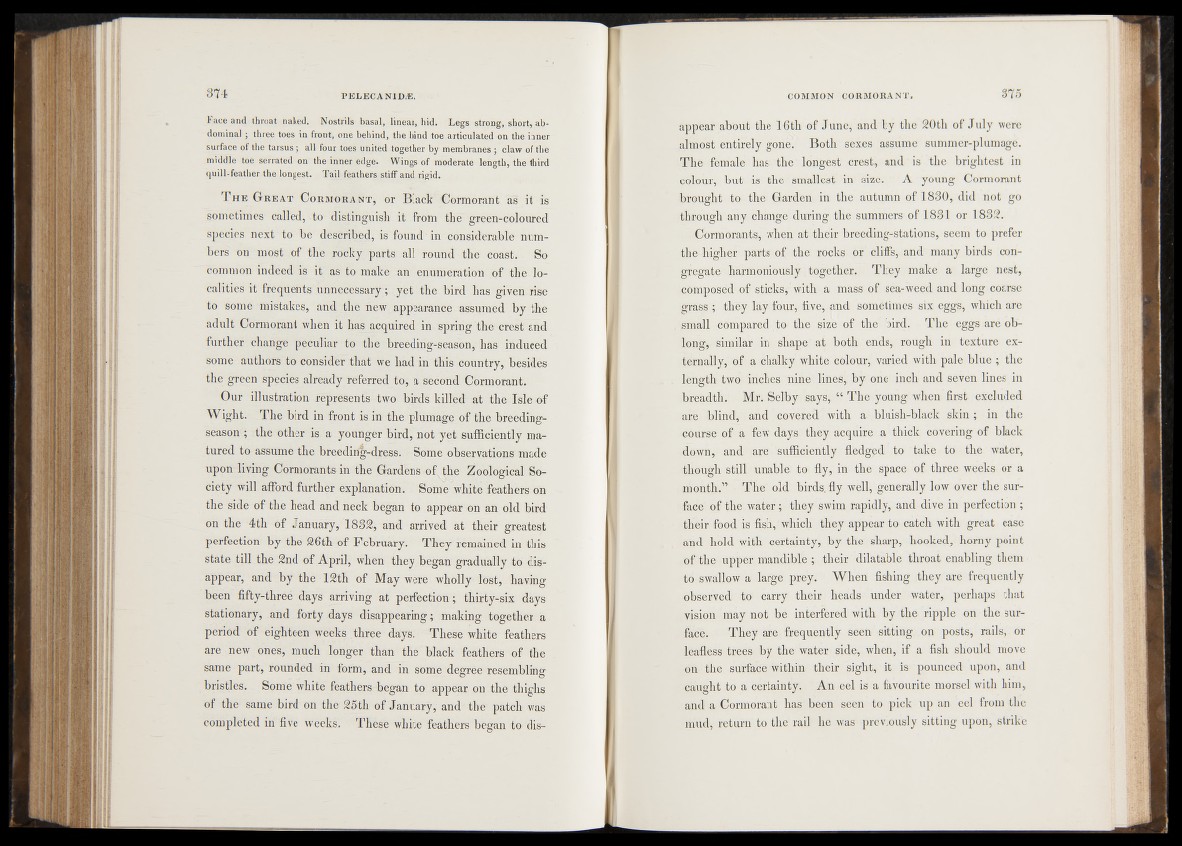
Face and throat naked. Nostrils basal, linear, hid. Legs strong, short, abdominal
j three toes in front, one behind, the hind toe,articulated on the inner
surface of the tarsus j all four-toes united together by membranes j claw of the
middle toe serrated on the inner edge. Wings of moderate length, the third
quill-feather the longest. Tail feathers stiff and rigid-.
T he Great Cormorant, or Black Cormorant as it is
.sometimes called, «.to-distinguish it from thd'green-coló'Urëd
species next* to' be described,!is:foundvin^cönsiderable numbers
on most of the rocky parts all round the coast. . So
common indeed is it as- to make an . enumeration b f the localities
it frequents unnecessary;; .yet the bird Üâs given.rise
to some mistakes, and.|liè new appearance assumed by the
adult Cormorant when it has acquired in spring theserest and
further change peculiar : to the “breeding-season, has induced
some authors to consider that we had in this fepuntry, Besides
lie green species-already referred top^fecond Cormorant^’
Our illustration representsitwo birds killed-at the Isle of
Wight. The bird in front is in the piumage^q’fc thebreeding-
season’; ;the other is a younger bird', not .yet sufficiently matured
to assume thé breeding-dress. -Some Observations' made
upon living Cormorants-in the Gardens ofythe Zoological Society
will, afford further explanafionf?? Soffie/wbite leathers On ,
the side of the head and neck began to appear on an old bird
on the 4th óf January, 18825 and arrived-bt .their’ greatest
perfection by the 26th of February: T h e / remained in this
state till the 2nd of April, when they.began gradually to disappear,
and by the -12tB of May were wholly^Iost, having
been fifty-threë daysjOTivihg at perfection’'; thirty-âx days
stationary, and forty days disappearing; -making-together a
period of eighteen wefeks .three da/s; - These white feathe’rs
are new ones, much longer than the black feathers of the
same part-, rounded-ini form, and in some degrée':resembling
bristles. Some white feathersrbegan to appear J h the thighs
of the same bird on the 25th of January, and'the patch was
completed in five weeks; These white feathers began to'disappear
about the 16th of June, and by the 20th of July were
almost entirely gone/ Both sexes assume summer-plumage.
The female has the' longest crest, and is‘ the brightest in
colour, but is! the? smallest: in size. A young Cormorant
brought to the Garden in the autumn o f 1880, did not go
through any change-during the summers o f l 881 or 1832.
, Corm oraut‘S|iwhen at" their breeding-stations, seem to prefer
thediigher parts of the rocks or cliffs, and many birds con-
^gÉegafce* harmoniously iffgether. They make a large nest,
composed-of/stieks/ with .admass of séa-weed and long coarse
grass ; itli^|*:fê/four, five; and- sometimes six eggs, which are
Small compared-to- the saSebf thel bird. .. The eggs are oblong,
lllmilar in shape at both ends, rough in texture externally,
of a chalky white;bol(||$, varied with pale blue ; the
length twofilches .nine- lines, by one/inch and seven lines in
breadth/ Mr&a^|l|)y/sary l^ “ The^oung' when first excluded
M|k/lblindk and with a f|B|uish-black skin ; in the
-có-urse1. of- ^ifêwfda^|lttóy/acq^^/,a thick covering of black
-down, and are’-sufficiently fledged to take té the water,
though-'still space of three-weeks or a
ftmontk’W^The' |fi||lird s. fly well; generally low over the surface
the .Water ;/th é /||§ h n rapidly, and dive in perfection ;
them food is fish, which they appear tó catch with great ease
and hhld with c^te^atyj sharp,* hooked, homy point
,'öf dhel'-uïpp|^maüdi'bl-e ; their dilatable throat enabling them /
^kofewallpÉ a lUrgiS prey. When’ fishing .they aré frequently
observed t-ö»- carry their heads under water, perhaps that
vision-’mayn'ot interfered with by the ripple on the surface.
They are frequently seen sitting .on posts, rails, or
^Ifafless trees, by the water side,: when, if a fish should move
;j;óh the surface within their, sight, it is pounced upon, and
c'aiught to a. certainty. An eel is a favourite morsel with him,
and a Cormorant has'been seem to pick up an eel from the
mud, return to thé rail he was previously sitting upon, strike